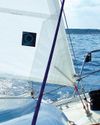Floating in air
Practical Boat Owner
|January 2021
Rupert Holmes explains some essential weather knowledge to help interpret forecasts on the water

Weather forecasting has changed enormously over the past few decades – there’s now a bewildering array of apps and websites that have the potential to give quite fine-grained data.
But at the same time, the way in which we receive and interact with weather data has also changed along with our expectations.
For example, despite the massive improvements in accuracy, forecasting still gets a bad press. Today’s predictions for six days’ time are as accurate as the 48-hour forecasts at the time of the 1979 Fastnet Race disaster and that ability continues to improve at the rate of a day per decade.
Yet interpreting what a forecast will actually mean on the water still requires some understanding of the basic elements of weather systems.
Weather is fundamentally created by the interaction between two distinct air masses with different properties: warm and wet vs dry and cold. Warm, moist air in the earth’s heat engine around the equator – the tropical regions – rises, while cold, dry air at the poles falls towards earth. The boundary between them – the polar front – can be very clear at times (see synoptic chart, above).
If the polar front passes over you, some rain will typically fall. This is because the warm, moist air is cooled on contact with the polar air turning the vapour into droplets that fall as rain.
The rotation of the earth causes these bodies of warm and cold air to spin, which in turn creates a kink in the polar front. This is the seed of a new low pressure system.
Denne historien er fra January 2021-utgaven av Practical Boat Owner.
Abonner på Magzter GOLD for å få tilgang til tusenvis av kuraterte premiumhistorier og over 9000 magasiner og aviser.
Allerede abonnent? Logg på
FLERE HISTORIER FRA Practical Boat Owner

Practical Boat Owner
An adventure to St Kilda
Marsali Taylor swaps skippering her Offshore 8m for being crew on a converted herring drifter, with comfy berths in the former fish hold
8 mins
January 2026

Practical Boat Owner
Mast refit and upgrade
Nicholas Koligiannis explains how he improved the mast on his Albin Ballad
5 mins
January 2026

Practical Boat Owner
Making more noise in fog
Nick Tyler takes the guesswork out of broadcasting fog signals
3 mins
January 2026

Practical Boat Owner
Solo across the Pacific
Triple amputee Craig Wood sailed into the history books with a non-stop, 90-day, 7,506-mile unassisted voyage
8 mins
January 2026
Practical Boat Owner
Al-assisted Shipping Forecasts
The Met Office has released new data showing a decade of steady improvement in the UK Shipping Forecast, with wind speed and sea state accuracy up by 10% or more.
1 min
January 2026

Practical Boat Owner
Bligh-ted reputation
Making the case for the mutiny on the Bounty's much maligned Captain Bligh
3 mins
January 2026

Practical Boat Owner
Wiper motor repair
Richard Stone mends his deck saloon windscreen wipers
2 mins
January 2026

Practical Boat Owner
'Let someone know boat plans' says report into fatal man overboard incident
The importance of designating a shore contact before setting off on a boat trip has been highlighted following a fatal man overboard incident near Inishbofin, Co. Galway, Ireland.
1 mins
January 2026

Practical Boat Owner
LITHIUM BATTERIES latest safety advice
Marine engineer and surveyor Marcus Jones unpicks the confusion surrounding the use of lithium batteries and what you should consider if installing them on board your boat
8 mins
January 2026

Practical Boat Owner
How to winterise your motor boat
Jon Mendez explains the steps you need to take to ensure your boat stays in top condition for next season
4 mins
January 2026
Translate
Change font size

